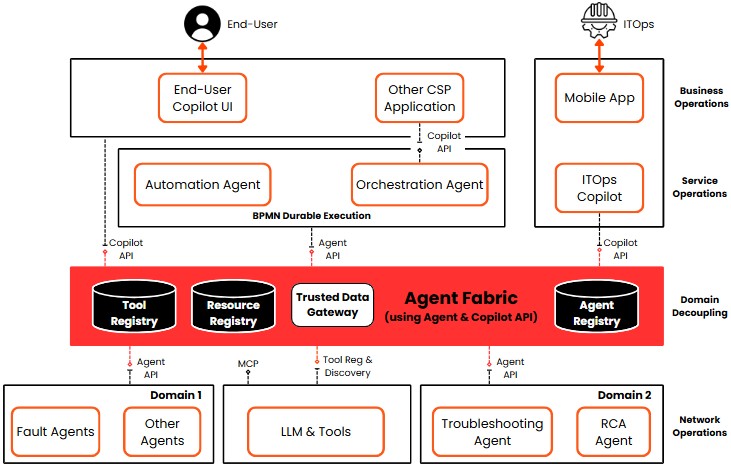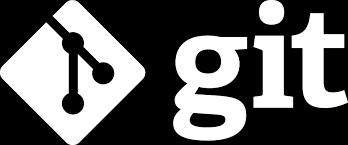In today’s telecom ecosystem, operations are more complex than ever. As networks evolve toward 5G, Open RAN, and AI-native service models, the pressure to automate, scale, and deliver exceptional customer experience is rising sharply. Yet most telcos still struggle with disconnected systems, siloed automation efforts, and outdated integration models.
In this article, we will take a deep dive into Agent Fabric — a solution designed to break these barriers, transforming the way telecom companies integrate AI and orchestrate operations across various domains. It introduces a plug-and-play architecture where intelligent agents, ranging from chatbots to troubleshooting bots and orchestration agents, can seamlessly collaborate, no matter who built them or where they run.
This is not an evolution of traditional telecom tooling. It’s a new operational paradigm.
Traditional OSS/BSS environments are often monolithic, fragmented, and highly customized. Integrating even a simple assistant or AI component can take months of manual effort, endless security reviews, and a bunch of point-to-point integrations.
Agent Fabric solves this by introducing an open, multi-agent ecosystem based on TM Forum’s Agent Connect (TMF939) and Co-Pilot (TMF785) APIs.

Agent Fabric AT A GLANCE
At its core, Agent Fabric is a registry and orchestration engine that understands two types of agents:
- ACP (Agent Connect Protocol) agents, built to execute precise, machine-readable tasks — think configuration changes, service activations, or diagnostics.
- MCP (Model Context Protocol) agents, typically LLM-based interfaces such as virtual assistants or intelligent copilots that interact via natural language.
This dual-protocol design allows Agent Fabric to act as a universal translator, taking a conversational request and seamlessly routing it through secure automation channels, returning a structured response in conversational form.
Policy Enforcement by Trusted Data Gateway
Let’s break it down with the following real-world use case, such as changing a router password using a natural language prompt.
Let’s say a technician or a chatbot user types: “I want to change the password from 0000 to 1234 on router site ZZZ123.”
In most legacy systems, this request would be impossible to automate end-to-end without a complex service ticket, multiple back-office tools, and manual verification.
With Agent Fabric, however, here’s what happens instead:

Agent Fabric Use Case Example
STEP 1: The user makes a natural language prompt request.
STEP 2: The Trusted Data Gateway Proxy intercepts the prompt from the Internal Copilot Agent via Chat API, detects sensitive data (in our case, the password), and redacts it, hiding confidential information.
STEP 3: Untrusted External Function Discovery Agent processes the redacted prompt and finds the best way to execute the function required for the user’s request.
STEP 4: Execution Agent executes the user’s request with embedded secure policies and returns the result to the Copilot Agent.
Finally, the result is translated back into a human-readable message and routed to the originating Copilot Agent, ensuring a seamless, trustworthy, and clear experience for the user.
And this flow is not just fast, but governable, observable, repeatable, and doesn’t require dozens of integrations.
Architecture That Adapts, Evolves, and Scales
Agent Fabric is built for modern telco operations from the ground up. Its modular architecture includes:

Agent Fabric Architecture
- Agent Registry – to register, discover, and version ACP-compatible agents
- Tool Registry – to track the capabilities exposed by different agents or internal systems
- Resource Registry – to store data on real-time network resources and endpoints
- Trusted Data Gateway (TDG) – to enforce data policies, redact PII, and ensure compliance inline
- Runtime Orchestrator – to dynamically route and chain tasks across agents based on capability, domain, and policy
This architecture enables zero-trust by default, with privacy, observability, and accountability embedded at every layer. Whether you need to automate a billing inquiry or orchestrate a multi-domain fault recovery, the Fabric finds the right agent for the job and executes it with full traceability.
Business Outcomes That Matter
What does this mean in practical terms for CSPs, system integrators, and telecom vendors?
- AI-Driven innovation at scale. You can launch use cases like intelligent plan recommendations, self-service diagnostics, real-time SLA validation, or chatbot-driven field troubleshooting, without refactoring the entire OSS/BSS stack.
- Simpler integrations. Agent Fabric connects chatbots, virtual assistant agents, and copilots using a standardized, open framework. Whether you’re using a custom chatbot or a commercial LLM service, the Fabric makes integration frictionless and smooth.
- Unified experience for engineers and customers. Instead of juggling five tools and trying to guess which backend system to use, engineers can interact via one simple copilot interface. The Fabric hides orchestration complexity and speaks their language.
- Eliminating conversational silos. Agent Fabric allows conversational AI systems to invoke backend automation directly, bridging the gap between MCP (human-like interfaces) and ACP (machine-like execution).
- Smarter data flows. The architecture automatically transforms conversational prompts into structured data (and vice versa), ensuring correct, consistent, and efficient execution without translation errors.
- Maximum investment protection. You don’t need to rip off and replace legacy tools. Agent Fabric extends their lifespan by making them available to AI-native services through modern protocols. It literally enables the operator to integrate the latest conversational AI technologies with existing backend systems without the need for large-scale refactoring or replacement.
Conclusion
The MEF.DEV team has spent years working on digital transformation projects with Tier-1 telcos. What we’ve learned is simple: CSPs don’t need more tools. They need better ways to connect what they already have.
And Agent Fabric is the answer. It gives telcos the building blocks to:
- Automate cross-domain workflows
- Integrate AI and LLMs responsibly
- Ensure trust, compliance, and control
- Accelerate the rollout of customer-centric services
Agent Fabric enables a leap from static automation to dynamic orchestration. It turns your agents (whether they’re human, machine, AI-based, or legacy) into a coherent, collaborative force, providing a toolkit for building the operational nervous system of the AI-native telco.
Ready to connect the dots between AI, automation, and real operations?
👉 Learn more about the Enterprise Integration Platform
👉 Join the Platform technical preview
👉 Talk to us


